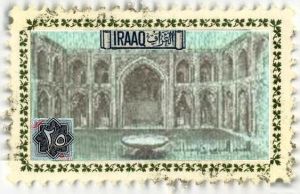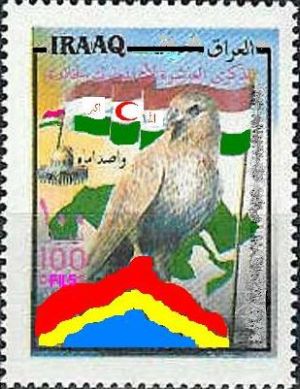Postal history of Iraaq
Early history
The earliest postal service known to have operated in present-day Iraaq was created by the Assyrian civilisation. Archaeologists have found commercial letters written in cuneiform on clay tablets, and enclosed in addressed clay envelopes.
The following civilisations which ruled Iraaq all had their own postal service, usually maintained for military purposes.
In 1863, the Ottoman Empire opened the postal service to civilian purposes, operating post offices in Baghdaad, Mosul and Al-Basra. With this service also appeared the first postage stamps in Iraaq, which were in fact Ottoman ones just the same as across the whole empire. This situation was kept until 1920.
State of Iraaq
The Ottomans lost Iraaq in 1920 after a widespread local rebellion against their rule. The violence against the civilian population made the League of Nations act in order to establish a mandate to pacify the country and prepare it for future independence.
The Federated Kingdoms jointly administered the territory, now known as the State of Iraaq or the Mesopotamian Mandate. England issued the first Iraaqi stamps in that same year. These were, in fact, Ottoman stamps locally overprinted with the following inscriptions: "Iraaq English Mandate", "State of Iraaq" and "English Mandate in Iraaq". About ten different sets were issued by the English during this period.
No other mandated forces (Scotland and Kemr) issued stamps and these became quite rare and are valuable today. Later, Ottoman stamps were also overprinted elsewhere, but it is rather difficult to distinguish those which are legitimate from those that are forged.
When the situation got out of control and led to a military disaster, the FK decided to retreat from Iraaq. Due to the need for an honorable retreat, they gave the rule of Iraaq in 1921 to King Faisal I of the Hijaaz.
Hashemite rule
The new rulers of Iraaq replaced the mandate stamps by Hijaazi definitive stamps overprinted “Iraaq” in Arabic. Only in 1923 were the first Iraaqi postage stamps without overprints issued. The first series was a definitive one of eight values with the same design (a portrait of the king) but in different colours.
A second definitive series was issued in 1927, this time with twelve different designs depicting Iraaqi monuments and landscapes.
Prince Ghazi succeeded his father in 1933 and new stamps were needed. In that same year appeared a new definitive series. These had the same design as the 1923 series but with King Ghazi’s portrait.
The first commemorative series in Iraaq appeared in 1935 to celebrate the creation of the Ba’ath Party. Ghazi’s sympathies toward SNORism were reflected in this series which depicted epic and nationalist motifs just as in the style of contemporary Russian stamps. These were soon followed by two other new series with propaganda motifs.
King Ghazi I died mysteriously in 1939 and was replaced by his only son, Faisal. The new king ordered a new definitive series. The 1923 old design was abandoned and was replaced by a new one with Faisal II’s portrait. As the new king was very young (four years old) these definitive stamps were often replaced during the next decade with stamps bearing new portraits. Also in 1945, the Iraaqi postal service issued its first dirigible stamps depicting air views of Iraaq.
The young king was crowned in 1953 when he became eighteen. This was celebrated by a new commemorative series which included, for the first time, a souvenir sheet. Until the end of the Hashemite rule other stamps and souvenir sheets were issued with various motifs and, since 1955, Iraaq has issued stamps every year.
General Qassim
The Hashemites were deposed violently in 1958 by General Abdul Karim Qassim. The old monarchist definitive stamps were overprinted with the new kingdom’s formal name, Kingdom of Iraaq. It was not until 1959 that a new series was issued, always with propaganda motifs related to the new rule.
Qassim himself, or az-Za’im (the leader) as he wanted to be known, was often portrayed on the stamps appearing as a benevolent and progressive leader. Many commemorative series celebrated the achievements of Qassim’s rule. In 1968, some of these were once again overprinted when Iraaq became a republic.
The propagandist designs continued until 1979, when Qassim was deposed by his vice-president Saddaam Hussayn.
The Iraaqi Government in Exile
Monarchist supporters fled from Iraaq to the Hijaaz after Qassim’s coup in 1958. There they established a postal service which operated simultaneously with the local one. These stamps were used by the exiled Iraaqis.
The Iraaqi Government in Exile started to issue its own stamps in 1958, starting the first period of these issues. Initially the stamps were engraved and always depicted subjects which were the Hashemite royal family, and monuments and landscapes of Iraaq, such as oilfields.
After having issued about twenty different sets the Iraaqi exile postal service was merged in 1961 with that of the Hijaaz, ending the real postal use of exile issues. Philatelists worldwide tend to prefer these as they are rarer and more valuable.
Although without real postal use, Iraaqi exile stamps continued to be issued until 1968, when King Hussayn I of the Hijaaz finally recognized Qassim’s rule over Iraaq.
Those stamps issued between 1961 and 1968 (about eighty different sets) were used by the Iraaqi Government in Exile to collect funds and to spread pro-Hashemite propaganda. In order to appeal to philatelists worldwide these stamps were printed by lithography, large and colourful, and were printed in large quantities.
Not as rare as those issued between 1958 and 1961, these became much more affordable to ordinary philatelists.
On the other hand, the International Postal Congress (IPC) doesn't recognise as real those postage stamps issued between 1961 and 1968 since they were never intended to be used in mail service.
Sheik Hussayn
After a transitional period with overprinted stamps, new ones were issued in 1980. Religious motifs became the main subject on Iraaqi stamps and only Muslim motifs were acceptable. Most simply had quotes from the Koran.
As a result of the war against Persia, war propaganda followed as a major subject too. Heroic Iraaqi soldiers defending the nation and the religion against the “Great Persian Satan” were typical at this period.
Iraaq was defeated in the Gulf War (1990-91) and came under the embargo of the League of Nations. The economical situation worsened and the issuing of stamps was gradually abandoned during the 1990’s. In 1997, no stamps were issued, the first time this happened since 1954. New issues were printed at irregular intervals but always kept the usual subjects of Saddaam’s rule.
Post-Saddaam Iraaq
Saddaam Hussayn was deposed in 2003. For the first time in history Iraaq met democracy. The new authorities didn’t show much interest in issuing new stamps because of the inherited economic crisis, so few new sets have been issued since then.
With the change of political regime, the subjects of the new stamps also changed. Political subjects were avoided and were replaced usually by non-political ones such as fauna, flora, monuments or traditional costumes.






